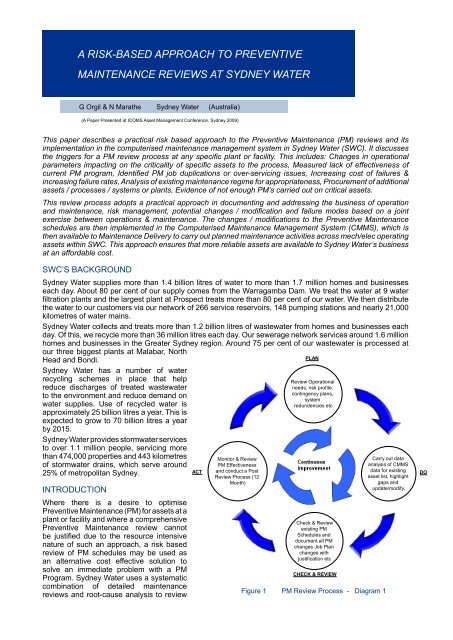SKF Reliability Systems - Library
SKF Reliability Systems - Library
SKF Reliability Systems - Library
You also want an ePaper? Increase the reach of your titles
YUMPU automatically turns print PDFs into web optimized ePapers that Google loves.
A RISK-BASED APPROACH TO PREVENTIVE<br />
MAINTENANCE REVIEWS AT SYDNEY WATER<br />
This paper describes a practical risk based approach to the Preventive Maintenance (PM) reviews and its<br />
implementation in the computerised maintenance management system in Sydney Water (SWC). It discusses<br />
the triggers for a PM review process at any specific plant or facility. This includes: Changes in operational<br />
parameters impacting on the criticality of specific assets to the process, Measured lack of effectiveness of<br />
current PM program, Identified PM job duplications or over-servicing issues, Increasing cost of failures &<br />
increasing failure rates, Analysis of existing maintenance regime for appropriateness, Procurement of additional<br />
assets / processes / systems or plants, Evidence of not enough PM’s carried out on critical assets.<br />
This review process adopts a practical approach in documenting and addressing the business of operation<br />
and maintenance, risk management, potential changes / modification and failure modes based on a joint<br />
exercise between operations & maintenance. The changes / modifications to the Preventive Maintenance<br />
schedules are then implemented in the Computerised Maintenance Management System (CMMS), which is<br />
then available to Maintenance Delivery to carry out planned maintenance activities across mech/elec operating<br />
assets within SWC. This approach ensures that more reliable assets are available to Sydney Water’s business<br />
at an affordable cost.<br />
SWC’S BACKGROUND<br />
Sydney Water supplies more than 1.4 billion litres of water to more than 1.7 million homes and businesses<br />
each day. About 80 per cent of our supply comes from the Warragamba Dam. We treat the water at 9 water<br />
filtration plants and the largest plant at Prospect treats more than 80 per cent of our water. We then distribute<br />
the water to our customers via our network of 266 service reservoirs, 148 pumping stations and nearly 21,000<br />
kilometres of water mains.<br />
Sydney Water collects and treats more than 1.2 billion litres of wastewater from homes and businesses each<br />
day. Of this, we recycle more than 36 million litres each day. Our sewerage network services around 1.6 million<br />
homes and businesses in the Greater Sydney region. Around 75 per cent of our wastewater is processed at<br />
our three biggest plants at Malabar, North<br />
Head and Bondi.<br />
Sydney Water has a number of water<br />
recycling schemes in place that help<br />
reduce discharges of treated wastewater<br />
to the environment and reduce demand on<br />
water supplies. Use of recycled water is<br />
approximately 25 billion litres a year. This is<br />
expected to grow to 70 billion litres a year<br />
by 2015.<br />
Sydney Water provides stormwater services<br />
to over 1.1 million people, servicing more<br />
than 474,000 properties and 443 kilometres<br />
of stormwater drains, which serve around<br />
25% of metropolitan Sydney.<br />
INTRODUCTION<br />
G Orgil & N Marathe Sydney Water (Australia)<br />
(A Paper Presented at ICOMS Asset Management Conference, Sydney 2009)<br />
Where there is a desire to optimise<br />
Preventive Maintenance (PM) for assets at a<br />
plant or facility and where a comprehensive<br />
Preventive Maintenance review cannot<br />
be justified due to the resource intensive<br />
nature of such an approach, a risk based<br />
review of PM schedules may be used as<br />
an alternative cost effective solution to<br />
solve an immediate problem with a PM<br />
Program. Sydney Water uses a systematic<br />
combination of detailed maintenance<br />
reviews and root-cause analysis to review<br />
ACT<br />
Monitor & Review<br />
PM Effectiveness<br />
and conduct a Post<br />
Review Process (12<br />
Month)<br />
PLAN<br />
Review Operational<br />
needs, risk profile,<br />
contingency plans,<br />
system<br />
redundencies etc<br />
Check & Review<br />
existing PM<br />
Schedules and<br />
document all PM<br />
changes Job Plan<br />
changes with<br />
justification etc<br />
CHECK & REVIEW<br />
Figure 1 PM Review Process - Diagram 1<br />
Carry out data<br />
analysis of CMMS<br />
data for existing<br />
asset list, highlight<br />
gaps and<br />
update/modify.<br />
DO

















